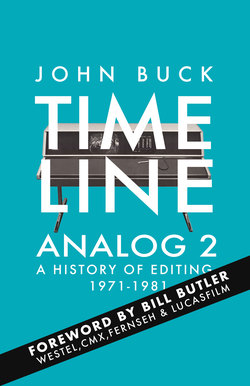Читать книгу Timeline Analog 2 - John Buck - Страница 1
Foreword by William (Bill) Butler
ОглавлениеAfter decades within the video industry, I landed at Memorex Corporation in 1970 - a critical time as it joined forces with the CBS Television Network to create a joint venture called CMX Systems.
In the following year our amazing team discovered and solved the key problems associated with creating a digital video editing machine. They confronted the hurdles to building an 'electronic Moviola', like how to achieve frame-by-frame storage of sufficient analog video in a large random access memory system; how to record analog video in real time in a digital storage system with individual frame identity; and how to design a user interface that looked familiar to a film editor.
The small group of engineers developed unique video processing and disc storage solutions over the course of 1970. Inventions like the brilliantly simple EDL (edit decision list) were so groundbreaking that they defined the editing industry for decades to come.
Although received with great acclaim it quickly became apparent that CMX’s end product, the CMX 600, was too radical. I believe Joseph Flaherty and others at CBS knew this from the beginning but they needed the CMX 600 as a lever to get things moving.
In the intervening twenty years, the editing industry reverted to a mix of analog and video machines built by former colleagues like Jim Adams and Dave Bargen as well as startups like Datatron and Convergence. This period also saw the emergence of Sony of Japan, first with its U-Matic and then 1” recorders that helped revolutionise access to broadcast images.
We knew all along that the limiting factors in electronic editing were video memory and videotape recorders. We also knew that the principal of exponentially increasing chip memory density and speed, with decreasing cost, was eventually going to solve both.
Moore’s Law held true and eventually the economic digitization and rapid processing of video became a reality. The videotape machine, which had supplanted film as editing’s medium, gave way to the personal computer as the preferred platform.
This book, Timeline Analog 2, concludes with George Lucas’ plan to mesh technology and imagination to create affordable digital video production. One that CMX 600 had already led the way. Bill Butler, January 2018
William (Bill) Butler's career spans 1955 to 1995 at Brush, Precision Instruments, Westel, Memorex, CMX Systems, Robert Bosch and Lucasfilm.
